Screen made of plastic pipes: types of partitions + step-by-step manufacturing instructions
A screen is a very effective solution for zoning a room.But the astronomical cost of such a partition in art studios inspires creativity, right? A self-made screen made of plastic pipes can become a multifunctional piece of furniture in a bedroom, studio apartment, children’s room and more.
Do you want to make a partition with your own hands, but don’t know where to start? We will help you deal with this issue - the article provides recommendations for creating a screen design project and preparing suitable materials for it.
The process of making a partition from pipes is also described in detail, photo options for screens that can be made with your own hands using scrap materials are considered. As a visual aid, thematic video materials with instructions for self-production have been selected.
The content of the article:
Types of screens and their purpose
The design of the future partition completely depends on the functions that it will perform and on the time available for the implementation of ideas.
Depending on the purpose, screens can perform the following functions:
- decorative – the partition is used to decorate the interior of the room, being an artistically designed object;
- division of space – the screen visually divides the room into zones, which is often used by designers in large rooms;
- implementation of creative ideas – a small screen made of pipes acts as theatrical equipment when performances are staged at home.
The size of the future product is also important for the project, so you should immediately decide on its function. Most often, partitions are made from plastic for a kindergarten group, for playing tabletop puppet theater, for fulfilling household needs, for zoning a one-room apartment, trying to separate an office from a bedroom or living room.
And also, this is a favorite craft of creative and creative craftswomen who prefer to make an unusual and completely unique thing with their own hands.
In principle, it is not at all difficult to buy a screen for every taste and size - manufacturers offer a huge range of different purposes from a wide variety of materials.
Ready-made solutions offered by art studios are not very expensive. Therefore, it is much more interesting to build a partition yourself.Moreover, there are always improvised materials at hand that will work, you just need to show your imagination.
You should immediately think about the design - mobile (on wheels), portable or stationary partition. It is also important whether it folds or not.
All these points need to be carefully considered, because the project of the future homemade screen depends on them.
Screen manufacturing process
Creating an original screen of the required size is quite a feasible task not only for the home craftsman, but also for the creative housewife.
Moreover, you can use improvised materials to make a homemade partition if it is not possible to rent a specialized tool for working with plastic pipes.
Step #1 - creating a homemade screen project
If you have to make a partition structure for use by children, then its dimensions should be selected taking into account the height of future users.
And for use as a decorative element in a room, it is important to determine the required dimensions - if you build a partition that is too small, it will not bring the desired result.
In addition, you need to decide on the shape of the screen, the number and dimensions of the sashes, as well as the type of homemade product - folding, mobile, stationary, etc.
The easiest way for beginners is to make a simple version of the partition with a combination of plastic pipe + textiles. Or a very original option - just pipes.
The advantage of using only plastic is moisture resistance. Such a product can be safely placed in a combined bathroom without fear that splashes will spoil the appearance of your masterpiece.
Step #2 - preparing the necessary materials
To work with metal-plastic pipes specialized tools will come in handy. If you don’t have them, you can rent or use improvised tools.
So, first of all, you will need plastic pipes. Their diameter and length depend on the draft of the future screen - the shape, height, length and width of the sashes.
A tool for soldering and cutting pipes is also useful - a special iron and pipe cutter.
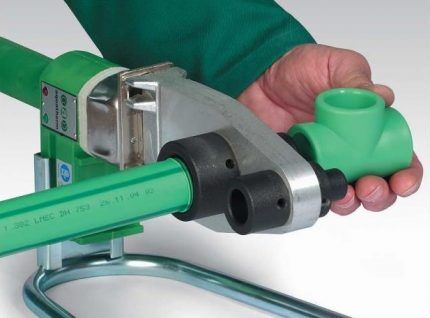
If out of stock soldering iron or pipe scissors, a lighter and a regular sharp knife or metal saw will do.Moreover, if the edges heat up, then they do not need to be processed additionally.
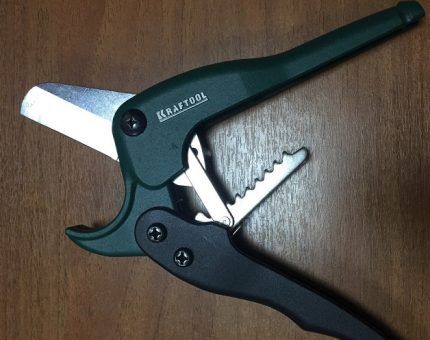
Step #3 - assembling the homemade product according to the project
In principle, the set of tools and materials depends on the design of the planned screen.
Depending on their purpose, products can be not only functional, but also decorative.
By the way, the latest version of the screen can be made in a large size to stage performances with the participation of live actors, rather than puppets.
Below we will consider two options for partitions made of plastic pipes, the manufacturing principles of which are radically different.
Option #1 - screen on wheels
If you decide to make a designer version for wet rooms, then you have to decide on the depth of the partition and its functionality.
The minimum depth should be about 5 cm - narrower material is inconvenient to work with. If you plan to put magazines and other useful little things in the cells of the partition, then you can add another 10-15 cm.
To make a designer version of the screen, you will first have to cut the pipes into pieces of the same length - this will be the depth of the homemade product. It is advisable to take pipes of different diameters.
It is important to treat the cut areas - after all, they will be open, so they should look beautiful and be safe. What is a regular iron and baking paper suitable for?
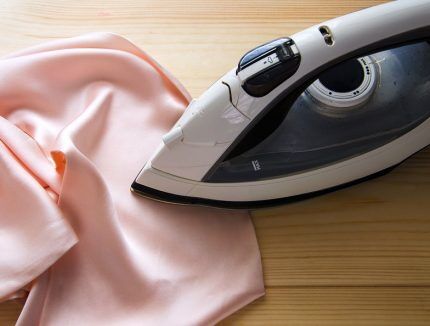
Then all prepared pipe sections should be placed on the floor or cardboard blank in a chaotic manner, choosing the most favorable location. This is exactly what your screen will look like in the future.
When the desired design is achieved, all that remains is to fasten all the elements together. What is glue used for?
After waiting the recommended number of minutes after applying the glue, you can start painting the finished structure in the desired color - crimson, light green, silver. Or leave the screen white.
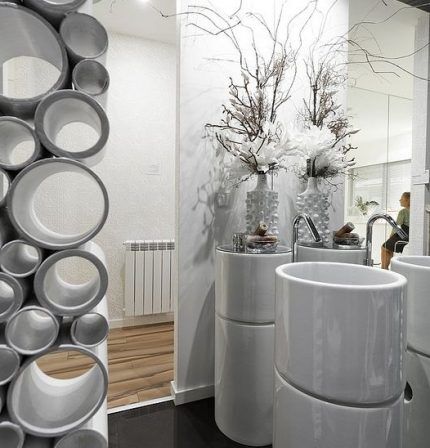
Finally, all that remains is to secure the partition or leave it mobile. Why you can use furniture wheels of the right size. They can be attached directly to the pipe sections of the lowest row.
Or, first attach the wheels to a wooden board or plastic surface, and then glue it to the bottom row of plastic pipes.
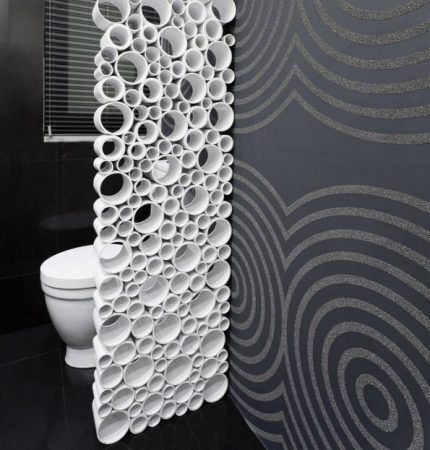
Option #2 - portable partition
To make a portable screen, you will need the same set of tools as in the previous version.
As for materials, first of all you will need pipes with a diameter of 20-25 mm. Their consumption depends entirely on the number of sashes - if there are 3 sashes and a height of up to 1 meter, then at least 10 meters. To join, it is convenient to heat them with an iron.
You will also need the following materials:
The procedure for making a three-leaf screen is simple. First you need to cut the required sections of the pipe - 0.6-0.8 m and 1.0-1.2 m. In this case, the edges should not be processed.
Next you need to do the following:
- Warm up the edges of one piece and the corner fitting - they need to be connected to each other.
- Alternately using fittings connect all the blanks in four sections, forming a rectangular frame.
- Attach fabric “walls” equipped with a window, pocket or mesh insert to each frame using Velcro or buttons. Velcro must first be sewn/glued to the textile.
- Connect the screen doors to each other using double-sided fasteners.
At this point, the manufacturing process of the assembled partition is ready. It can be used for games in the garden, for classes, or for staging a performance with puppets if you add a window to the design.
If you use the mesh as a material for a plastic frame, then children can easily engage in independent creativity, weaving into it an original pattern of colored ribbons.
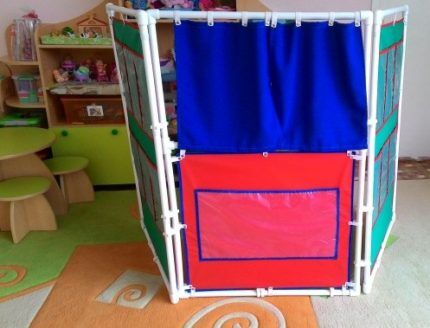
If you increase the height of the homemade screen to 1.6-1.7 meters and use textiles with appropriate motifs as decoration, then you may well end up with a beautiful partition for the bedroom, hiding behind which it will be pleasant to change clothes.
There are several more articles on our website where we examined in detail various homemade products made from plastic pipes. We recommend reading them too:
Conclusions and useful video on the topic
Video recommendations on how to create a partition from pipes yourself:
A partition made of plastic tubes can become not only an active participant in children's games or a room divider, but also an effective element in interior design.
Moreover, it is quite possible to make a decorative screen with your own hands. Why can you use plastic pipes and available materials? And also show a little imagination.And then the result will definitely please you.
Have you ever had to build a screen from PVC pipes yourself? Please share photos of your own homemade products and instructions for making them. Leave your comments in the block below.




I really like the look of the screen made from plastic pipes cut into rings - really stylish and modern. The black one in the photo above is especially beautiful. But the author wrote everything correctly about cleaning. You can shoot yourself, how many horizontal planes there are.
All other options, when pipes are used specifically for the frame, are not particularly impressive. It may look unusual, but at the same time it looks cheap in the bad sense of the word. I hope I don't offend anyone. Fencing something off in the yard or at the dacha in the summer is quite an option. Making a screen for children's games is also quite possible. Especially when you consider that children break half of what they see))) Breakage will not cost much. But going home “permanently” as a decoration - nooo... Something is wrong. I repeat: with the exception of the screen, which is all made of rings. This one is simply beautiful!
I think that such products are mainly made for the dacha/garage. Although I don’t agree that it looks cheap. With the proper skill, even if not the first time, you can still get nice looking screens.
What about sticking it in the bathtub and dousing it in the shower?
And the idea is, in principle, excellent and quite original! From the category of “the need for invention is cunning.” It’s not difficult to make a screen yourself if you want, if you have the desire. But personally, I would not do this, there is no energy from plastic products, I think that it simply does not exist.I prefer products made from wood, from natural materials, they are “warm and lively”, although they are more expensive, they bring real comfort to the house.
How much cheaper is this than a regular screen? Is the game worth the candle, as they say?
Let's really look into this issue. I don’t know why the article does not list prices for screens made of plastic pipes, but this is a serious omission.
I just looked at the current price tag:
1. 10 m2 of fabric (we take the most affordable polyester) - $17;
2. 12 m of PVC pipe d20 - $6;
3. Elbow for PVC pipe d20, 6 pcs. — 0.7$;
4. Tee for PVC pipe d20, 6 pcs. — $0.9
5. Fastening PVC pipe d20, packaging - $1.5.
Total: $26.1.
Quite an affordable option. I also sketched out a rough diagram with calculations for clarity, by hand, so I’m waiting for a photo of the finished screen from you.
You can borrow a machine for welding plastic pipes from someone, if not, then attach it to glue through adapters.
And if you collect the remains of pipes from your friends/neighbors, it’s a pretty penny anyway :)